The walk up the hill to the Swayambhunath caitya from Chhauni is popular amongst locals on this side of the city. Past the Army Head Quarters and the Chhauni museum, the snow white caitya suddenly comes into view, atop a heavily wooded small hill. Prayer flags flutter in the wind, branching out from the top of the stupa in all directions. Higher up, past the cross roads, the winding, wide roads that go up the hill finally come into view. Dense, purple Jacaranda trees line one side of the road with Kathmandu sprawled out on the other side. In the mornings, a brisk walk up the hill with the air still crisp is a must. A lot of locals come up here for a good stretch and to take a short walk around the main caitya. In the evenings, the bright lights of the town of temples beckon you to take your sweet time strolling up or down the hill.
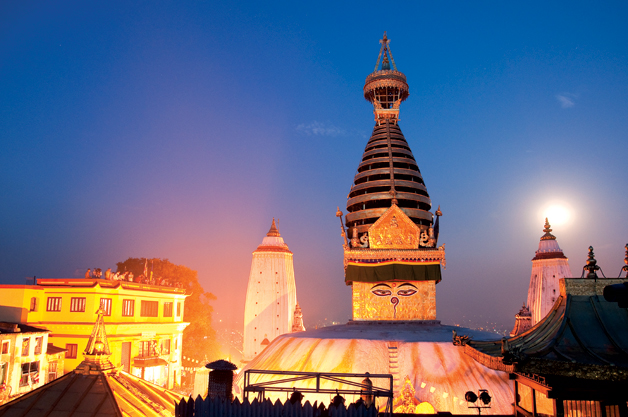
The restored Swayambhunath, aglow in the evening lights, attracts a crowd of onlookers.
Once up, across the parking lot, the small water body with the Buddha statue in the middle and the mostly kitschy souvenir stalls, a long flight of stone steps leads to the top of the hill. From here, the path to your left will lead you up and around a bright yellow statue of the Buddha and more caityas. These smaller caityas too are significant as they symbolize the faith of the many devotees who had them installed here over the course of hundreds of years. There is a small tea shop that offers Tibetan delicacies and sweet, milk tea at the end of another smaller flight of stairs. The Sherpa didi who owns the shop speaks terrific Newari, often surprising many who sit down for a cuppa. In front of her shop are many more souvenir shops, selling everything from landscape art to Buddhist prayer music. Amidst all of this activity and life rests the magnificent Swayambhunath caitya. The sheer size and detail on the caitya is something to write home about already, but Swayambhunath is more than just a pretty site with a view. Besides being one of the three main caityas of the country – Namo Buddha and Bouddhanath being the other two - it is also the world’s oldest stupa.
But you’d be fooled of its significance if you saw how casually devotees make their customary rounds around it, bowing their heads in prayer, offering rice grains and money and lighting butter lamps in front of it. It might be because the locals are used to having so much prestigious art, architecture and history lying on their doorsteps, that they simply fail to see the caitya or any other important architectural/religious/cultural structure in the same light that many visitors do. This is quite unfortunate as Nepal is blessed in terms of its heritage of art and architecture. But part of the charm of this historic caitya is that it has not been cordoned off and reduced into being a museum piece. The caitya is always surrounded by life. Many people live in the houses around the caitya; the caitya is in the middle of their communal courtyard. People earn their living in its shade, selling souvenirs with the Swayambhu brand – postcards, prayer wheels, beads and incense amongst others. It is a huge symbol of faith in one’s religion and hardly a day goes by when different puja ceremonies aren’t in full swing at the stupa or in front of the adjacent Hariti temple. Stray dogs, monkeys, pigeons – it’s just like any another neighborhood, except that it’s not just that. And the caitya belongs here, not like a set of seesaws in a park but like a big tree or a cool pond in an open field, something that is so essentially a part of this place that it’s treated like everything else. And thus the sooty marks on the caitya from the innumerable butter lamps lit by devotees, the worn off gold plating on the Buddha’s images from many a coin thrown in offering and the everyday litter on the ground, candy wrappers, matchsticks, pieces of paper – from the life around the living, breathing monument.
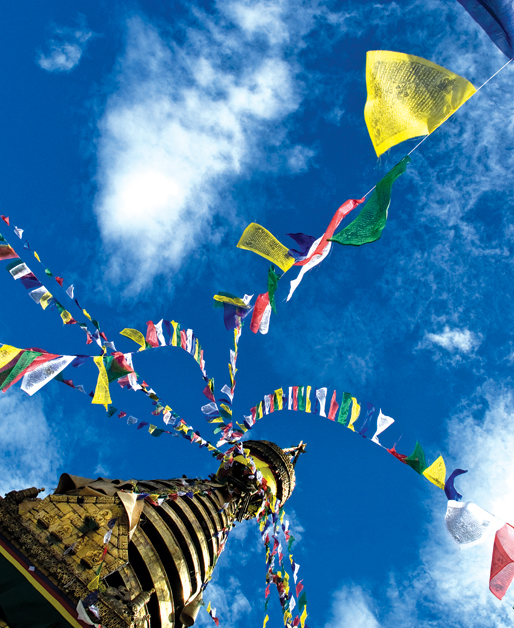
Prayer flags flutter into the wind, reaching our aspirations into the heavens
Wear and tear of such proportions would have reduced it to the ground one would think. And that’d be correct because the caitya we see today is not the same caitya that was built so many centuries ago. The deterioration over the years, due to natural causes did allow for many restorations. In fact the stupa has been dismantled completely many times and has even undergone a significant increase in size (by exactly one third to be precise) sometime between the 14th-15th century and 1712 A.D. The latter date has been recorded as the year of completion of one of many renovations. The proportions of the caitya have remained the same throughout.
There are some sources that say the caitya was built around the 5th or the 7th century but proof of this is hardly substantial. From the 14th century however, there are concrete records that mention Swayambhu and its restoration. Within roughly 450 years or more, precisely from 1370 to 1820 A.D., it was completely renewed at least 12 times. These renovations were major affairs too. It was not just a fix-what-is-broken job; the caitya was - in accordance with the treatises on this subject - dismantled down to the dome. Except for the metal which is melted down and reused, the dismantled parts are discarded ritually. This also include the massive central wooden pole, called the yasti which traverses the entire structure and the parasol. The divine essence or the nyasa helps maintain the continuity between the old and the new caityas. It is ritually extracted and stored in water vessels for the duration of the restoration and reinstalled once work is completed. The caitya’s filial and crest jewel are mostly reused. The eternal, the omniscient; fills the onlooker's mind with devotion and calm The gold-plated main spire stands magnificent against the night sky
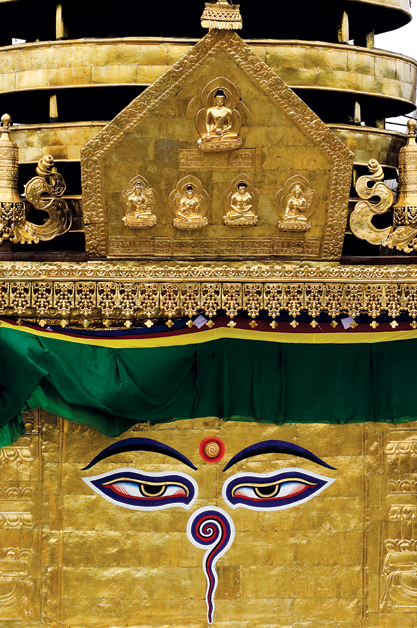
Swayambhu represents the provenance of all caityas, stupas, viharas and monasteries and is a vantage point for all three vehicles – Sravakayana, Mahayana and Vajrayana. Even more important is the kind of religious tolerance it has inspired as a unique heritage site, providing common religious grounds for Hinduism and Buddhism. For these and many other reasons, it was listed as a UNSESCO World Heritage Site in 1979 A.D.
The partly mythological, partly factual history of the Swayambhu caitya’s origin has been well documented by Hem Raj Shakya in his book Sri Swayambhu Mahacaitya. The noted scholar of Newar Buddhism and epigraphy talks about the origins of the Kathmandu valley - a lake before it was supposedly drained by Bodhisattva Manjusri. It is said that Manjusri had a vision of a lotus at Swayambhu which means ‘self created’ – a name that comes from an eternal, self existent flame. The Bodhisattva traveled to the lake to worship it and seeing that the valley could be a great place for a settlement and to make the site more accessible to human pilgrims, Manjusri cut a gorge at Chovar. The water drained out of the lake, leaving a fertile valley which is present day Kathmandu. A lotus plant that blossomed here was transformed into a hill and the flower is said to have become the Swayambhu stupa.
The book also notes the active involvement of several royal dynasties that ruled over the country in the past, in work related to the caitya. Malla era King, Nripendra Malla is credited to having aided the reconstruction of the road to the stupa while King Parthivendra Malla is credited with having one of its many renovations done in Nepal Sambat 802. The book also mentions details of the involvement of locals such as Mr. Nhuche Raj and Mr. Tirtha Raj Manandhar of Makhan Tole in Kathtmandu who funded the construction of the many stone steps that lead to the stupa. Finishing the steps alone took five years. There are a total of 318 stone steps, measuring a total of 2100 feet in height and ten feet in width.
The Swayambhu Restoration Project
The recently concluded 15th major restoration of the Swayambhu caitya was a major affair lasting two whole years. Starting in May 2008, the lengthy project was coincidentally and very auspiciously completed on the Nepali month that marks Buddha Jayanti. Funding for such a huge undertaking came from the Tibetan Nyingma Meditation Center (TNMC), one of America’s oldest Buddhist organizations. While there are usually fundraisers and such to raise money for such large scale projects, this time the funds came from Rinpoche Tarthang Tulku who heads the Tibetan Nyingma Institute. The work was undertaken in cooperation with Nepal’s Department of Archeology (DoA) and support from the local Federation of Swayambhu Management and Conservation.
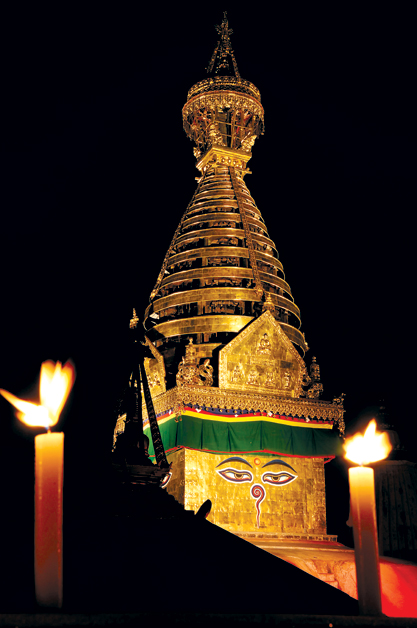
But working in Nepal, with the ineffectual and infamous snail’s pace referred to fondly as “Nepali time” that government officials seem to run on, needless to say has innumerable disadvantages. In her makeshift office, perched atop the same hillock that houses the Swayambhu caitya, Gellek explained the many obstacles they faced during the duration of the work. Some locals wouldn’t always be so trusting, cocking a suspicious eye at the workers taking down piece after piece from the caitya. Now, these structures have immense historic and thus monetary value and Gellek says she can understand how people could have been anxious seeing an outsider handle the work. But some good did come out of all this suspicion. Because members of the committee would demand records of every single thing they were doing and ask to be present when dealings were made involving gold, it all resulted in a very detailed database with over 40,000 images of the various stages of work that happened here. The photos which are aided by detailed captions and lengthy descriptions of almost every step of the process are in themselves quite an achievement. Tsering jokes that maintaining these records for the officials was more hard work than the actual restoration!
Another good thing that came out of the restoration was the team that was brought together to work on the caitya. The almost hundred-strong team of artisans from their respective fields of expertise worked odd hours for two full years to get the caitya looking the way it does today. Gellek says the workers even turned up on holidays and political bandhs to finish pending work. More than just an artist, such dedication was exactly what the project needed to overcome the many obstacles that it faced. But such is the power of the caitya that everything would always work out in the end. Now that their work is done, the group that worked on the caitya wants to continue to work together on other projects. Plans for such have been discussed too.
The initial plan was however for a restoration of the Bouddhanath stupa. After that did not work out, plans to restore Swayambhu came up and finally saw the light of day. As to what triggered the restoration at this particular time, there might be several reasons. Senior Buddhist monks often have visions that allow them to take these decisions. There is also mention of a mythological god who is said to live in Swayambhu and who travels to Tibet and asks for such a restoration whenever the caitya is in a state of disrepair.
But whatever the reason may be, the Swayambhu caitya saw its first restoration in over 90 years completed successfully. The work done focused on the repair, cleaning, and gilding of all the copper-plated sections of the Stupa including the nine shrines around the stupa’s base, the 76-foot tall spire and harmika, and the large vajra and Dharmadatu mandala situated in front of the stupa on its eastern side. The metal plates of the stupa were cleaned, with experts repairing and restoring the damaged sections to their original form with each plate finally receiving a fresh layer of gold.
The re-gilding part of the project is one of the largest restorations of gold work in the world and was done in the traditional Nepali style. Gold mixed with mercury was applied to the copper sheets and then heated to burn off the mercury, leaving a layer of gold covering the entire surface. Repair of the metal sections of the stupa except for cast figures and sculpted elements was done through the traditional repoussé method. Additional repairs too were undertaken on damaged sections of the wooden structure within the cornice and harmika. Each phase of the work was carefully monitored and recorded by the Center for Documentation and Conservation, yielding an invaluable record that will prove a very useful guide for future scholarly research.
At the end, centuries old rituals that are specific to the renovation process were conducted for the first time in a hundred years involving hundreds of priests from around the valley. There were separate ceremonies by Tibetan and Newar Buddhists to mark the end of the restoration on the caitya with the main ceremony taking place on 9 July with invitations to all involved, both directly and indirectly.
The Aftermath of a Restoration
Tsering Gellek loves Nepal and traveled from the other side of the world to make this wonderful and humbling contribution to the country. More than a hundred Nepali artisans were employed to work on the stupa, an opportunity that allowed them to showcase their skills, and work on a truly historic project. To ensure the safety of all concerned, helmets and harnesses were made compulsory when going up or down the stupa while taking it down and also while putting it back up. Lok Ratna Shakya, a pivotal character who was in charge of the gold work passed away during the duration of the project. His wife and daughters continued to devote their time and efforts to the successful completion of the stupa. The stupa shines brighter than before today, inspiring many ‘oohs’ and ‘aahs’ from all those who are seeing it after long. Even the energy of the place seems revitalized due to the restoration.
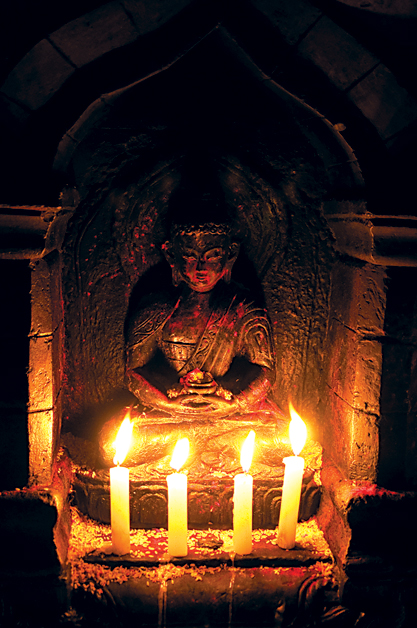 People don’t exactly embrace social and moral obligations. And in a country like Nepal, ignoring the same has become the norm. But the questions will not go away. What roles and responsibilities should we take up now to preserve this restored stupa? How can we delay the inevitable wear and tear on it? Should these be moral obligations for the hundreds of devotees who go up to Swayambhu? What can and what will we do to make a difference?
People don’t exactly embrace social and moral obligations. And in a country like Nepal, ignoring the same has become the norm. But the questions will not go away. What roles and responsibilities should we take up now to preserve this restored stupa? How can we delay the inevitable wear and tear on it? Should these be moral obligations for the hundreds of devotees who go up to Swayambhu? What can and what will we do to make a difference?
Mohan Shakya, Advisor for the Swayambhu Restoration Project, was involved with the project right from the start. Shakya was instrumental in checking the quality of the gold that was used in the gold plating process and stresses on the fact that the standard of work was of the highest grade. “The locals and the priests have to take the role of spreading awareness about what is good and what is bad for the stupa and clearly set down the dos and don’ts for devotees to follow when they come to Swayambhu. If this is done, it will be very hard for people to do otherwise. But again, this is easier said than done. Even the monkeys wreak havoc by playing a significant role in the wear and tear,” he opines, when asked about how Swayambhu can be better taken care of.
There are also new factors that will and are affecting the preservation of the ancient caitya. Global warming and phenomena such as acid rain contribute towards shortening the life span of the restoration considerably; the wear and tear on the caitya gets accelerated to a great deal. The next restoration might have to be sooner than we think. Also the exponential population growth in the valley is sure to have adverse effects on the caitya, with more people passing through, which would mean more butter lamps and more wear and tear.
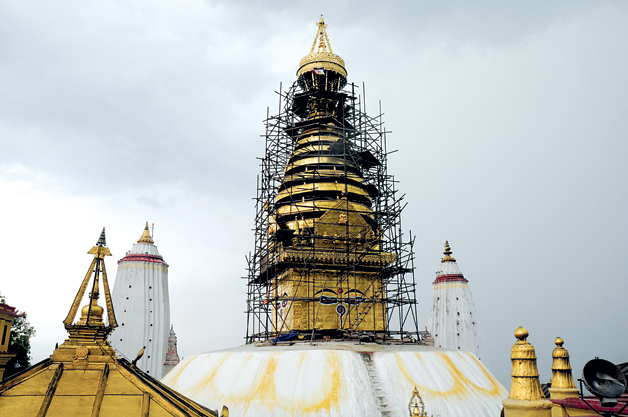
The restoration work involved labour of love from hundreds of master artisans
The answers really point towards the Nepali populace and nowhere else; the good news being that all of this can be changed, slowly but surely. And what is essential is not asking for funds for renovations but a healthy change of attitude. With the passage of time, the changing weather patterns will affect the stupa for sure, but with time there should also be a proportional amount of interest in the direction of finding ways to fight these adverse effects. Also, the rise in population also means more manpower and more ideas. All of it depends on how we look at the problem. As Gellek said, no one would bother if they dumped garbage in the streets in Nepal but the minute someone started cleaning up the garbage, ten people come forward to inquire about it. A change in such attitude will go a long way not just for preservation of the historic caitya but also many other important monuments that Nepal is a treasure trove of.
References: A Historical Overview of the Renovations of the Svayambhūcaitya at Kathmandu, Alexander Von Rospatt, Berkeley
Sri Svayambhu Mahacaitya, Hem Raj Shakya (Translated by Min Bahadur Shakya) 2004 C.E.










